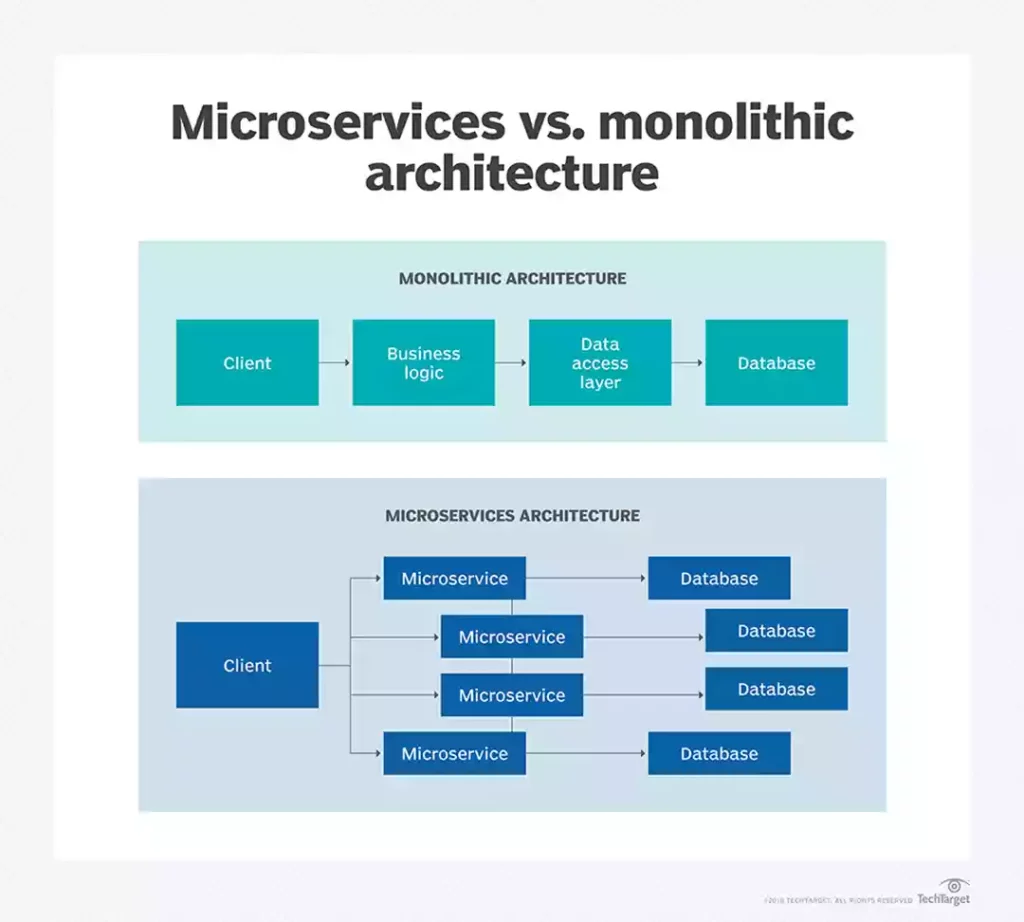5 core components of microservices architecture
Learn about the 5 core microservices components to help deploy faster and cost-efficient.
If you have been involved with any major software deployment like ERP or PLM software implementation, you know you better have project skills.
Microservices are rapidly becoming the go-to architecture for many modern companies. It’s a distributed system that allows developers to build, deploy, and scale individual services independently. This makes it easier to manage large applications and adapt quickly to changing business needs.
A good microservices architecture offers several benefits, including:
- Scalability: They can be scaled independently, meaning that you can scale up the services experiencing the most traffic without scaling up the entire application. This can lead to significant cost savings.
- Resilience: Microservices are more resilient to failures than monolithic applications. If one microservice fails, the other services can continue to operate. This can help to reduce downtime and improve the overall reliability of your application.
- Agility: Microservices can be developed, deployed, and updated independently. This makes it easier to change your application and release new features more quickly.
- Technology independence: Microservices can be implemented using different programming languages and technologies. This gives you the flexibility to choose the best job tools and avoid vendor lock-in.
- Ease of development and maintenance: Microservices are typically smaller and simpler than monolithic applications. This makes them easier to develop, maintain, and test.
In addition to these benefits, microservices can also help to improve team productivity, data security, and compliance.
Here are some examples of how companies have benefited from using microservices systems:
- Netflix: Netflix uses microservices to power its streaming platform. This allows Netflix to scale its service to handle millions of concurrent users and to release new features more quickly.
- Amazon: Amazon uses microservices to power its e-commerce platform. This allows Amazon to scale its service to handle massive spikes in traffic during peak shopping periods.
- Spotify: Spotify uses microservices to power its music streaming service. This allows Spotify to deliver a personalized user experience and roll out new features quickly.
Overall, a good microservices systems can offer several benefits for businesses of all sizes. However, it is important to note that microservices are not a silver bullet. There are also some challenges associated with implementing and managing architecture systems.
If you are considering using microservices architecture, it is important to evaluate your needs carefully and to choose the right tools and technologies for the job.
This blog post will discuss microservices, their benefits, how they work in practice, and some challenges you may face when implementing them in your organization. We’ll also provide tips on how best to use microservices so you can get maximum value out of them. So, let’s dive right in!
What are microservices, and why do I need them?

Microservices architecture (often shortened to microservices) is an architectural style for developing applications. Microservices allow a large application to be separated into smaller independent parts, each having its own realm of responsibility.
Let’s explore how microservices can benefit your business! Services architecture is a software design pattern that encourages the development of applications as a suite of small, independent services. This improves website deployment by allowing changes to be made more quickly.
As the head of technology for a company, you are constantly tasked with finding innovative ways to improve the business. You need to keep up with the latest trends and anticipate future needs.
The world of technology is always changing, and it can be hard to keep up with every new trend. Not only do you need to stay current, but you also need to be able to see beyond the present and plan for the future.
CIOs need a partner who understands both the present and future of technology. We work closely with our clients to understand their needs and help them stay ahead of the curve. Contact us today, and let us show you how we can help your business thrive!
Microservices offer several advantages over traditional, monolithic applications.

They are:
- Flexible: Microservices are highly modular and can be deployed independently. This makes them much more flexible than monolithic applications, which are often difficult to change without affecting the entire system.
- Scalable: It’s easy to scale individual microservices without impacting others. This allows you to improve performance by scaling only the needed services.
- Resilient: If one microservice fails, the others can run unaffected. This increases overall system stability and resilience.
- Fast: Microservices can be deployed quickly and easily, thanks to their small size and independence from each other.
- Easier to understand: Smaller services are easier to understand and work with than large, monolithic applications. This makes development and debugging simpler and more efficient.
Microservices are a great way to improve your web applications’ flexibility, scalability, and resilience. If you’re looking for a way to make your applications more responsive to change, microservices are worth considering!
Are you looking for a way to make your applications more responsive to change?
Microservices offer several advantages over traditional, monolithic applications.
Microservices are a great way to improve your web applications’ flexibility, scalability, and resilience. If you’re looking for a way to make your applications more responsive to change, microservices are worth considering!
What are the different architectures of microservices?
While there are dozens of ways to implement architecture patterns, three topologies are the most common and popular: the API REST-based topology, application REST-based topology, and the centralized messaging topology.
How do I get started with microservices?
Microservices seem like a great solution for improving web applications, but how do you start with them?
Here are a few tips:
- Start small: Don’t try to tackle your entire application at once. Start by converting a small part of it into a microservice. This will help you get used to the new working method and make any mistakes early on.
- Use the right tools: Several tools can help you with microservices development and deployment. Choose the ones that work best for you and your team.
- Plan for failure: As with any new technology, there is always the risk of failure. Plan for things to go wrong and have contingencies in place.
- Please communicate with your team: Make sure they know what microservices are and how they work. This will help ensure everyone is on the same page and avoid confusion.
- Have fun: Microservices can be great fun to work with! Experiment and see what works best for you and your team.
Why are microservices the future of web development?
Microservices are the future of web development for many reasons:
- Flexibility: Microservices allow you to quickly and easily adapt to changes in your business or the marketplace. This flexibility is essential in today’s ever-changing world.
- Scalability: Microservices make it easy to scale your applications as needed. This allows you to improve performance and meet the needs of your customers.
- Resilience: If one microservice fails, the others can run unaffected. This increases system stability and resilience.
- Efficiency: Microservices are small and independent, making them fast and easy to deploy.
- Simplicity: Smaller services are easier to understand and work with than large, monolithic applications. This makes development and debugging simpler and more efficient.
Microservices are the future of web development for all of these reasons!
How will microservices impact my business?
Microservices offer several advantages over traditional monolithic applications, and more businesses are beginning to adopt them. But what are microservices, and why do you need them? We will cover the 5 core components of microservices.
These advantages make microservices attractive for businesses looking to improve their web applications.
The 5 core components of microservices architecture
Microservices are composed of five core components:
- Services: This is the heart of microservices, where your business logic lives.
- APIs: These provide a way for services to communicate with each other.
- Databases: This is where your application data is stored.
- Schedulers: These control when services run and how they interact.
- Monitoring: This ensures that your microservices are running properly and collect data for analysis.
How does each of The 5 core components of technology architecture work?
How each component works is vital if you want to use it to deploy websites. We’ve been using it for 15 years.
Services: This is the heart of microservices, where your business logic lives. In architecture, services are small, self-contained units that perform a specific task. For example, a service might be responsible for handling customer orders or processing payments.
APIs: These provide a way for services to communicate with each other. APIs allow services to exchange data and functionality, making building complex applications from smaller components easy.
Databases: This is where your application data is stored. Each service has a database tailored specifically to its needs in a microservices rather than a monolithic to microservices architecture. This prevents services from interfering with each other’s data and keeps the database structure simple and clean.
Schedulers: These control when services run and how they interact. Schedulers ensure that services run in the correct order and that they are properly coordinated. They also allow services to be run asynchronously, which can improve performance.
Monitoring: This ensures that your microservices are running properly and collect data for analysis. Monitoring systems keep track of all aspects of microservice architecture, from individual service health to overall system performance. This data can be used to troubleshoot problems and improve system reliability.
CFO should care about microservices for risk management and cost savings.
Risk Management: The CFO should first care about microservices because they help reduce risk. By breaking an application into smaller, isolated services, microservices make identifying and fixing problems easier. If one service fails, the others can continue to run unaffected, which minimizes the risk of an outage.
Additionally, microservices can help prevent capacity issues leading to downtime by making it easy to scale services as needed. Because each service has its database, data loss is minimized in a failure.
Cost Savings: The second reason the CFO should care about microservices is that they can save money. Microservices are highly efficient, making them easy and fast to deploy. This means you can get new features and updates to your customers quickly without incurring the costs of a lengthy development cycle.
Additionally, microservices can be deployed at a fraction of the cost of traditional monolithic applications using commodity hardware and open-source software. This makes them an attractive option for businesses on a tight budget.
What is the meaning of Monolithic application?
A monolithic application is a single, large software application composed of all the code necessary to perform all the required business functions.
Monolithic applications are typically deployed as a single unit and can be difficult to scale and adapt to changing requirements. AIProdPad Product Development Transformation Through AI-Driven Innovation [White Paper]
What is a microservices design pattern?

Microservices are a distributed system that allows you to break your application into smaller, isolated services. This makes them easy to develop, deploy, and manage. Additionally, microservices can improve performance and scalability.
There are various ways to structure your microservices, but most follow a common design pattern. This pattern consists of five core components.
What do micro architects do?
Microservice architects design and build microservice-based systems. They must deeply understand distributed systems and how to make them work efficiently. Additionally, microservice architects must be able to orchestrate the various services that make up a system and ensure they are properly coordinated.
Additionally, microservice architects must be able to monitor and troubleshoot microservice-based systems. This requires a deep understanding of system internals and how the various services interact.
What are microservice frameworks?
Microservice frameworks are libraries or toolkits that help you build microservices. They provide all the functionality you need to create and manage microservices, including:
- Service registration
- Service discovery
- Service orchestration
- Service monitoring
- Service routing
Conclusion about microservices design pattern
If you want to see how monolithic to microservices work, we missed something.
Microservices are becoming more popular because they offer several advantages over traditional monolithic applications.
They make it easy to scale services and can be deployed at a fraction of the cost of traditional monolithic applications. CFOs should care about microservices for risk management and cost savings.
General FAQs about microservices design pattern
What is microservices architecture?

System architecture separates large applications into smaller, more manageable components. These components are isolated and can be deployed and managed independently. This makes microservices popular for businesses that want to improve agility and scalability.
What are the benefits of using microservices architecture?

There are several benefits to using microservices architecture, including improved agility, scalability, and efficiency. Additionally, microservices can help prevent capacity issues and make managing and deploying applications easier.
How can I transition my application to microservices architecture?

Transitioning to microservices architecture can be a daunting task, but there are several things you can do to make the process easier. First, identify parts of your application that would benefit from being broken into smaller services. Next, create a plan for how these services will interact. Then, determine the infrastructure you’ll need to support your microservices. Finally, start migrating your services one at a time.
How do I know if microservices architecture is right for my business?

Microservices architecture is popular for businesses that want to improve agility and scalability. Additionally, microservices can be deployed using commodity hardware and open-source software. Before switching to microservices, you should ask yourself a few questions and get help from a consulting firm.


